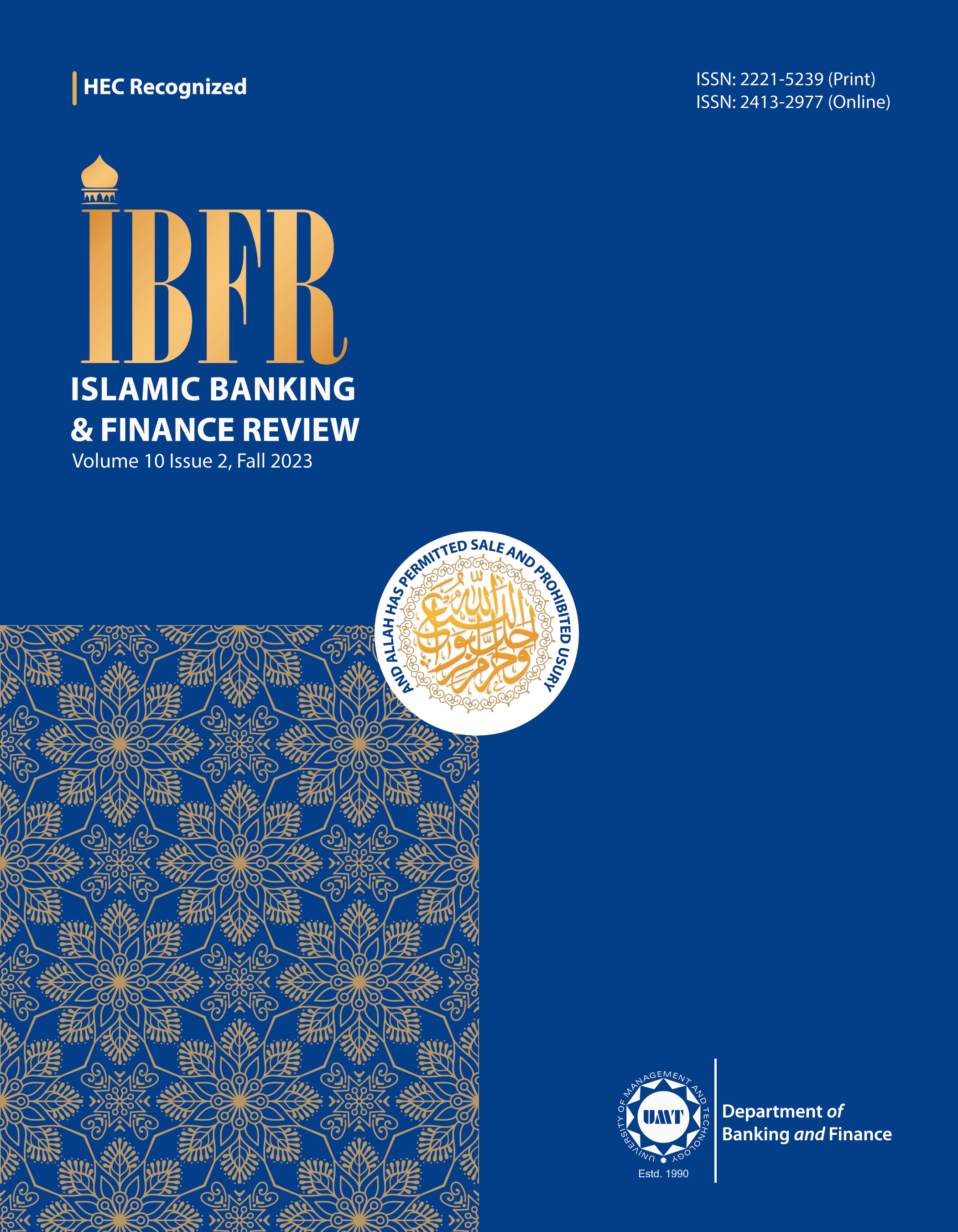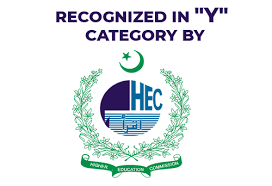Investigation of Shariah Compliant Green Firm Performance Using Eco-Efficient Infrastructure and Green Organizational Capabilities:
Abstract
 Abstract Views: 0
Abstract Views: 0
The primary goal of this study is to investigate the impact of eco-efficient infrastructure and organizational capabilities on shariah compliant shariah compliant green organizational performance, with shariah compliant sustainable production serving as a moderator. To achieve the study's goal, data were collected from 528 respondents in the manufacturing sector using a stratified sampling technique. The findings showed that a firm's eco-efficient infrastructure and organizational capabilities play an important role in achieving green performance; additionally, Shariah-Compliant Sustainable Production plays an important mediating role. This study contributes to the development of policies for organizations to improve their green performance and theoretically eco-efficient infrastructure, which has been overlooked in previous literature.
Downloads
References
Ahmad, N. A., & Sulaiman, M. (2016). Islamic stakeholder theory: A conceptual framework for corporate social responsibility in an Islamic economy. Journal of Business Ethics, 139(2), 207–224.
Ahmed, R. R., Akbar, W., Aijaz, M., Channar, Z. A., Ahmed, F., & Parmar, V. (2023). The role of green innovation on environmental and organizational performance: Moderation of human resource practices and management commitment. Heliyon, 9(1), Article e12679 https://doi.org/10.1016/j.heliyon.2022.e12679
Ahmed, R. R., Streimikiene, D., & Zheng, X. (2021). The impact of proactive environmental strategy on competitive and sustainable development of organizations. Journal of Competitiveness, 13(4), 5–24. https://doi.org/10.7441/joc.2021.04.01
Akgün, A. E., Keskin, H., & Byrne, J. (2009). Organizational emotional capability, product and process innovation, and firm performance: An empirical analysis. Journal of Engineering and Technology Management, 26(3), 103–130. https://doi.org/10.1016/j.jengtecman.2009.06.008
Al-Haddad, A. A., & Rahmad, D. (2016). Integrating Islamic values into corporate social responsibility reporting: An empirical study. Journal of Business Ethics, 139(2), 243–265.
Awaysheh, A., & Klassen, R. D. (2010). The impact of supply chain structure on the use of supplier socially reSCSPonsible practices. International Journal of Operations & Production Management, 30(12), 1246–1268. https://doi.org/10.1108/01443571011094253
Babu, S., Das, A., Singh, R., Mohapatra, K., Kumar, S., Rathore, S. S., & Panwar, A. (2023). Designing an energy efficient, economically feasible, and environmentally robust integrated farming system model for sustainable food production in the Indian Himalayas. Sustainable Food Technology, 1(1), 126–142. https://doi.org/10.1039/D2FB00016D
Berl, A., Gelenbe, E., Di Girolamo, M., Giuliani, G., De Meer, H., Dang, M. Q., & Pentikousis, K. (2010). Energy-efficient cloud computing. The Computer Journal, 53(7), 1045–1051. https://doi.org/10.1093/comjnl/bxp080
Bertassini, A. C., Ometto, A. R., Severengiz, S., & Gerolamo, M. C. (2021). Circular economy and sustainability: The role of organizational behaviour in the transition journey. Business Strategy and the Environment, 30(7), 3160–3193. https://doi.org/10.1002/bse.2796
Bleischwitz, R., & Hennicke, P. (2004). Eco-efficiency, regulation, and sustainable business: towards a governance structure for sustainable development: Edward Elgar Publishing.
Bocken, N. M., Niessen, L., & Short, S. W. (2022). The sufficiency-based circular economy—an analysis of 150 companies. Frontiers in Sustainability, 3, Article e899289. https://doi.org/10.3389/frsus.2022.899289
Boesch, D. F. (2006). Scientific requirements for ecosystem-based management in the restoration of Chesapeake Bay and Coastal Louisiana. Ecological engineering, 26(1), 6–26. https://doi.org/10.1016/j.ecoleng.2005.09.004
Cai, W., Wang, L., Li, L., Xie, J., Jia, S., Zhang, X., Jiang, Z., & Lai, K.-h. (2022). A review on methods of energy performance improvement towards sustainable manufacturing from perSCSPectives of energy monitoring, evaluation, optimization and benchmarking. Renewable and Sustainable Energy Reviews, 159, Article e112227. https://doi.org/10.1016/j.rser.2022.112227
Chew, M. Y., Conejos, S., & Azril, F. H. B. (2019). Design for maintainability of high-rise vertical green facades. Building Research & Information, 47(4), 453–467. https://doi.org/10.1080/09613218.2018.1440716
Ciceri, N. C., Garetti, M., & SPerandio, S. (2010, September 21–23). From product end-of-life sustainable considerations to design management (Paper presentation). Advances in Production Management Systems. New Challenges, New Approaches - IFIP WG 5.7 International Conference, APMS 2009, Bordeaux, France.
De Sousa, A. B. L. J., Jabbour, C. J. C., Godinho Filho, M., & Roubaud, D. (2018). Industry 4.0 and the circular economy: a proposed research agenda and original roadmap for sustainable operations. Annals of Operations Research, 270, 273–286. https://doi.org/10.1007/s10479-018-2772-8
Du Bois, A., & Sabri, N. A. (2016). The evolution of Islamic stakeholder theory: A review of the literature. Journal of Business Ethics, 139(2), 187–206.
Elstak, M. N., Bhatt, M., Van Riel, C. B., Pratt, M. G., & Berens, G. A. (2015). Organizational identification during a merger: The role of self‐enhancement and uncertainty reduction motives during a major organizational change. Journal of Management Studies, 52(1), 32–62. https://doi.org/10.1111/joms.12105
Fitzgerald, J. (2010). Emerald cities: Urban sustainability and economic development: Oxford University Press.
Freudenreich, B., Lüdeke-Freund, F., & Schaltegger, S. (2020). A stakeholder theory perSCSPective on business models: Value creation for sustainability. Journal of Business Ethics, 166, 3–18. https://doi.org/10.1007/s10551-019-04112-z
Garvare, R., & Johansson, P. (2010). Management for sustainability–a stakeholder theory. Total Quality Management, 21(7), 737–744. https://doi.org/10.1080/14783363.2010.483095
Ghisellini, P., Cialani, C., & Ulgiati, S. (2016). A review on circular economy: The expected transition to a balanced interplay of environmental and economic systems. Journal of Cleaner Production, 114, 11–32. https://doi.org/10.1016/j.jclepro.2015.09.007
Giannakis, M., & Papadopoulos, T. (2016). Supply chain sustainability: A risk management approach. International Journal of Production Economics, 171, 455–470. https://doi.org/10.1016/j.jclepro.2015.09.007
Hassan, M., & Ali, M. I. (2014). Islamic perspective on corporate social responsibility and stakeholder theory: A critical review. Journal of Business Ethics, 123(4), 629–648.
Hair, J., Joe, F., Sarstedt, M., Matthews, L. M., & Ringle, C. M. (2016). Identifying and treating unobserved heterogeneity with FIMIX-PLS: part I–method. European Business Review, 28(1), 63–76. https://doi.org/10.1108/ebr-09-2015-0094
Hart, S. L., & Milstein, M. B. (2003). Creating sustainable value. Academy of Management Perspectives, 17(2), 56–67. https://doi.org/10.5465/ame.2003.10025194
Henningsson, S., Hyde, K., Smith, A., & Campbell, M. (2004). The value of resource efficiency in the food industry: A waste minimisation project in East Anglia, UK. Journal of Cleaner Production, 12(5), 505–512. https://doi.org/10.1016/S0959-6526(03)00104-5
Hörisch, J., Freeman, R. E., & Schaltegger, S. (2014). Applying stakeholder theory in sustainability management: Links, similarities, dissimilarities, and a conceptual framework. Organization & Environment, 27(4), 328–346. https://doi.org/10.1177/1086026614535786
Jayamaha, D. L. (2007). Energy-efficient building systems: Mcgraw-hill publishing Company.
Khan, U., & Liu, W. (2023). Does environmental reSCSPonsible effect human resources management practice on firm effectiveness and green technology innovation? Environmental Science and Pollution Research, 30(13), 36160–36175. https://doi.org/10.1007/s11356-022-24845-1
King A. A., & Lenox, M. J. (2001). Does it really pay to be green? An empirical study of firm environmental and financial performance: An empirical study of firm environmental and financial performance. Journal of Industrial Ecology, 5(1), 105–116. https://doi.org/10.1162/108819801753358526
Kujala, J., Heikkinen, A., & Blomberg, A. (2023). Stakeholder engagement in a sustainable circular economy: Theoretical and practical perspectives. Springer. https://doi.org/10.1007/978-3-031-31937-2
Kumar, A. (2021). Design of a sustainable habitat: A theoretical framework for implementing sustainability in the building industry [Doctoral Disertion]. Sharda University.
Lages, L. F., Catarino, N., Gomes, E., Toh, P., Reis-Marques, C., Mohr, M., . . . Grosso, N. (2023). Solutions for the commercialization challenges of Horizon Europe and earth observation consortia: co-creation, innovation, decision-making, tech-transfer, and sustainability actions. Electronic Commerce Research, 23, 1621–1663. https://doi.org/10.1007/s10660-023-09675-8
Lee, V.-H., Ooi, K.-B., Chong, A. Y.-L., & Seow, C. (2014). Creating technological innovation via green supply chain management: An empirical analysis. Expert Systems with Applications, 41(16), 6983–6994. https://doi.org/10.1016/j.eswa.2014.05.022
Li, Y., Li, Z., Xing, B., Li, H., Ma, Z., Zhang, W., Reubroycharoen. P., & Wang, S. (2021). Green conversion of bamboo chips into high-performance phenol adsorbent and supercapacitor electrodes by simultaneous activation and nitrogen doping. Journal Of Analytical and Applied Pyrolysis, 155, Article e105072. https://doi.org/10.1016/j.jaap.2021.105072
Mastini, R., Kallis, G., & Hickel, J. (2021). A green new deal without growth? Ecological Economics, 179, Article e106832. https://doi.org/10.1016/j.ecolecon.2020.106832
Mathivathanan, D., Agarwal, V., Mathiyazhagan, K., Saikouk, T., & Appolloni, A. (2022). Modeling the pressures for sustainability adoption in the Indian automotive context. Journal of Cleaner Production, 342, Article e130972. https://doi.org/10.1016/j.jclepro.2022.130972
Molina‐Azorín, J. F., Claver‐Cortés, E., López‐Gamero, M. D., & Tarí, J. J. (2009). Green management and financial performance: a literature review. Management Decision, 47(7), 1080–1100. https://doi.org/10.1108/00251740910978313
Mondal, S., & Sahu, T. N. (2023). Do green initiatives and green performance affect firm performance? Empirical evidence from India. Asian Journal of Business Ethics, 12, 1–17. https://doi.org/10.1007/s13520-023-00175-4
Nguyen, X. H., Nguyen, K. L., Nguyen, T. V. H., Nguyen, T. T. H., & Ta, V. L. (2023). The Impact of green organizational capabilities on competitive advantage of construction enterprises in Vietnam: The mediating role of green innovation. Sustainability, 15(16), Article e12371. https://doi.org/10.3390/su151612371
Omer, A. M. (2008a). Energy, environment and sustainable development. Renewable and Sustainable Energy Reviews, 12(9), 2265–2300. https://doi.org/10.1016/j.rser.2007.05.001
Omer, A. M. (2008b). Green energies and the environment. Renewable and Sustainable Energy Reviews, 12(7), 1789–1821. https://doi.org/10.1016/j.rser.2006.05.009
Podsakoff, P. M., MacKenzie, S. B., Lee, J.-Y., & Podsakoff, N. P. (2003). Common method biases in behavioral research: a critical review of the literature and recommended remedies. Journal of Applied Psychology, 88(5), 879–903. https://doi.org/10.1037/0021-9010.88.5.879
Rahman, M., Wahab, S. A., & Latiff, A. S. A. (2023). The Underlying Theories of Organizational Sustainability: The Motivation Perspective. Journal of Business and Management Studies, 5(1), 181–193. https://doi.org/10.32996/jbms.2023.5.1.18
Rashed, A.-A. A., & Abdallah, A. A. M. (2016). Islamic perspectives on stakeholder management: A conceptual framework. Journal of Business Ethics, 139(2), 225–242.
Rasoolimanesh, S. M. (2022). Discriminant validity assessment in PLS-SEM: A comprehensive composite-based approach. Data Analysis Perspectives Journal, 3(2), 1–8.
Ringle, C. M., Wende, S., & Will, A. (2005). Smart PLS 2.0 M3. University of Hamburg.
Saroop, S. H., & Allopi, D. (2016). The use of eco efficient criteria in the design of infrastructure projects. International Journal of Sustainable Development and Planning, 11(1), 15–22. https://doi.org/10.2495/SDP-V11-N1-15-22
Singh, R., Khan, S., & Dsilva, J. (2023). A framework for assessment of critical factor for circular economy practice implementation. Journal of Modelling in Management, 18(5), 1476–1497. https://doi.org/10.1108/JM2-06-2021-0145
Su, L., & Swanson, S. R. (2019). Perceived corporate social reSCSPonsibility's impact on the well-being and supportive green behaviors of hotel employees: The mediating role of the employee-corporate relationship. Tourism Management, 72, 437–450. https://doi.org/10.1016/j.tourman.2019.01.009
United Nations. (1987). Report of the world commission on environment and development: Our common future. https://www.are.admin.ch/are/en/home/media/publications/sustainable-development/brundtland-report.html
Veleva, V., & Ellenbecker, M. (2001). Indicators of sustainable production: framework and methodology. Journal of Cleaner Production, 9(6), 519–549. https://doi.org/10.1016/S0959-6526(01)00010-5
Waddock, S. A., Bodwell, C., & Graves, S. B. (2002). ReSCSPonsibility: The new business imperative. Academy of Management Perspectives, 16(2), 132–148. https://doi.org/10.5465/ame.2002.7173581
Wang, Z., Yang, L., Yin, J., & Zhang, B. (2018). Assessment and prediction of environmental sustainability in China based on a modified ecological footprint model. Resources, Conservation and Recycling, 132, 301–313. https://doi.org/10.1016/j.resconrec.2017.05.003
Xie, S., & Hayase, K. (2007). Corporate environmental performance evaluation: a measurement model and a new concept. Business Strategy and the Environment, 16(2), 148–168. https://doi.org/10.1002/bse.493
Yacob, P., Wong, L. S., & Khor, S. C. (2019). An empirical investigation of green initiatives and environmental sustainability for manufacturing SMEs. Journal of Manufacturing Technology Management, 30(1), 2–25. https://doi.org/10.1108/JMTM-08-2017-0153
Yang, M., Chen, L., Msigwa, G., Tang, K. H. D., & Yap, P.-S. (2022). Implications of COVID-19 on global environmental pollution and carbon emissions with strategies for sustainability in the COVID-19 era. Science of the Total Environment, 809, Article e151657. https://doi.org/10.1016/j.scitotenv.2021.151657
Copyright (c) 2023 Uzma kashif

This work is licensed under a Creative Commons Attribution 4.0 International License.
Authors retain copyright and grant the journal right of first publication with the work simultaneously licensed under a Creative Commons Attribution (CC-BY) 4.0 License that allows others to share the work with an acknowledgement of the work’s authorship and initial publication in this journal.












